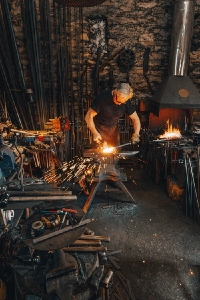The main three processes of Forging are:
Drop Forging:
This method is achieved by compressing heated metal between two dies, the top is forced onto the heated material and pushed into the shape of the die. As it cools the metal gains increased strength.
Hand Forging:
This method is carried out by skilled workers by hand. The basic method involves heating the metal and bending it into shape, by manual force.
Upset Forging:
This is achieved by using a preheated bar into a groove, this is held in place, pressure is then applied, this forces the end of the bar into a die and then it will reform it into the mould shape.
When did forging start?
The trade of forging dates to at least 4000 BC, some even say it is before then, stating that it is at least 6000 years old. Many of the production processes have improved since then but the basic principle of forging stays the same.
There are many forging companies out there, many have skilled forgers that can make any bespoke forging that you may require. Do your research, look at the company and its employers experience, and read their reviews, this will help you choose the right forging company for you. Many companies specialise in bespoke forgings as well as the standard processes that you may need.
We would always suggest talking to your forging specialist and allow them to guide and advise you if you are not sure which type of forging process, it is that you need.
